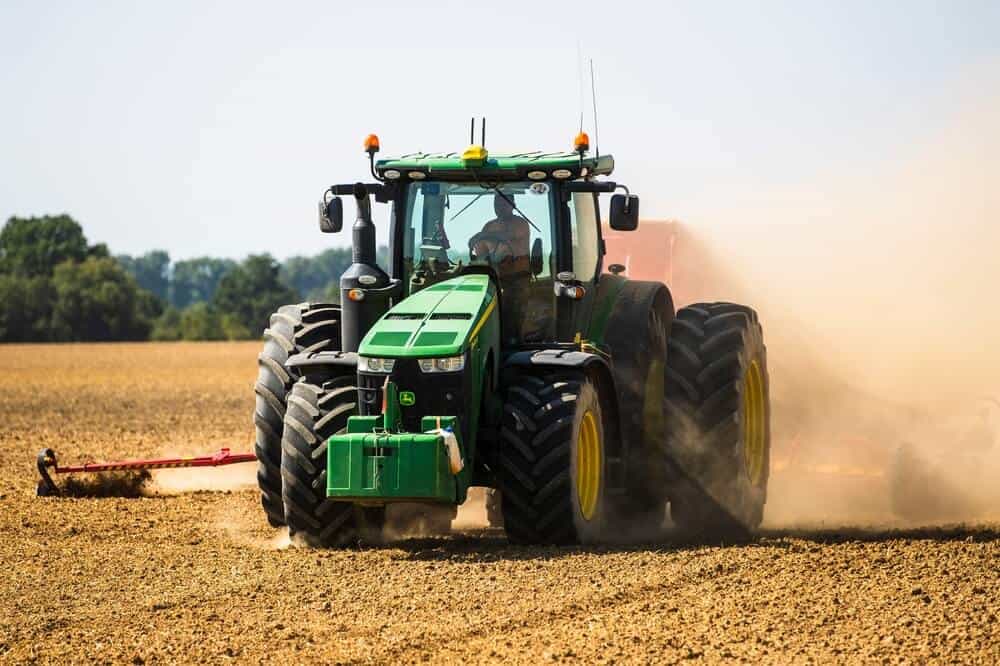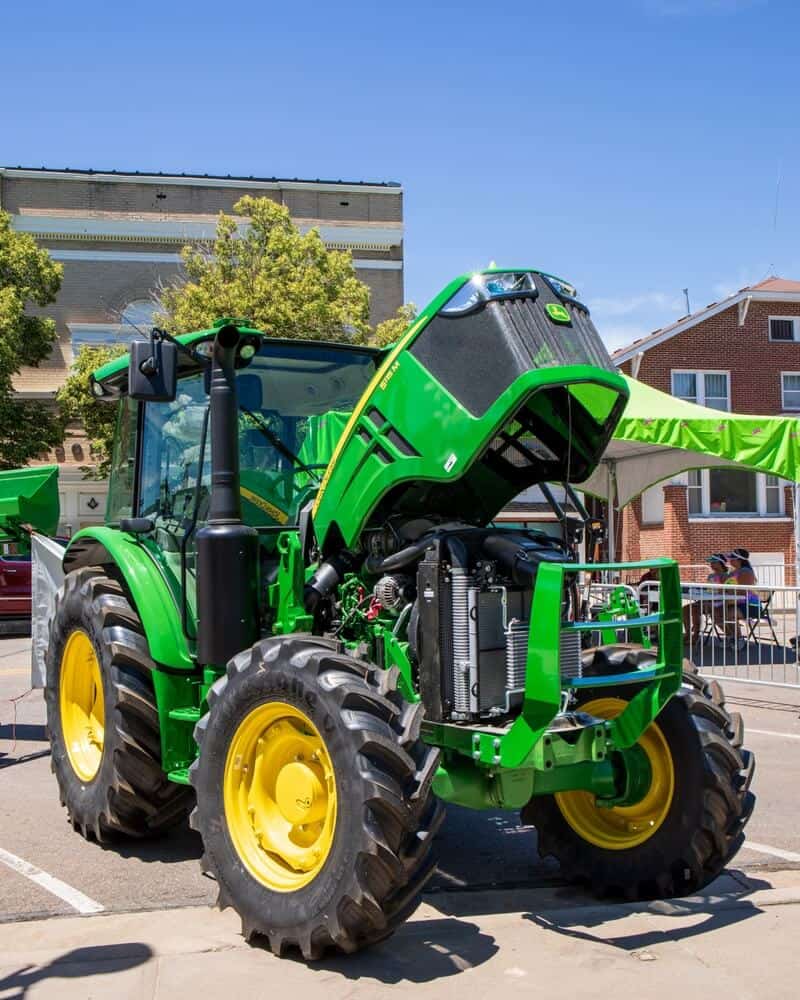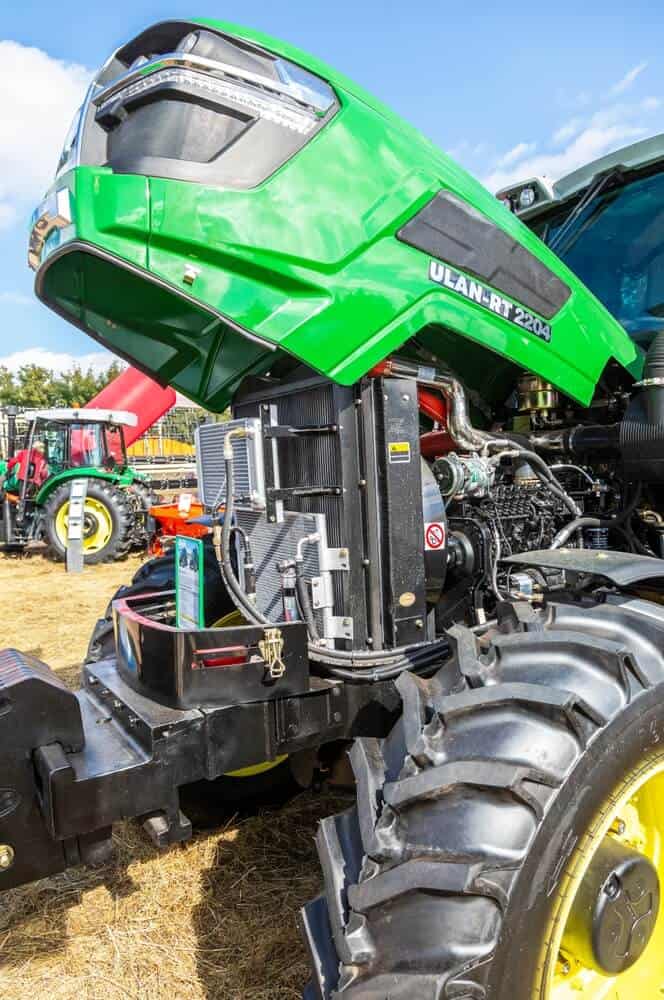Whether you work on a large or small farm, you most likely need a tractor for various hauling and other heavy-duty operations.
Depending on size, a new small tractor costs anywhere from $10,000 up to $200,000, or more, for a large one. However, if you want to save money, compare new tractor prices with used models.
Usually, there are plenty available on the market. And if you buy a pre-owned model, tractor prices are very affordable.
So, whichever one you choose, always set aside a certain amount for attachments. Otherwise, your tractor won’t reach its full potential.

If we look at the pricing of accessories, we should set aside $5,000 or so for complicated attachments. However, some cost far less, such as a rake, probably one of the cheapest, at just a few hundred dollars.
Usually, you need a tractor to pull a plow, rake, backhoe, or simply a trailer.
But, with the right attachments, you can use a tractor for many other purposes, such as an earthmoving dozer, powering a circular saw, and many other operations you might not have considered.
However, it’s not just farmers that use these machines. Usually, landscapers, construction workers, golf clubs, and even ordinary people with extensive gardens use compact tractors or sub-compact tractors.
Topics
How Much Does a Tractor Cost?

The table below gives price comparisons of various models available in the US, used as a farm tractor or for other purposes.
Usually, tractor manufacturers don’t display quotes on their websites. Also, it’s almost impossible to give a full range of all the differing tractor models and prices available.
Therefore, we looked at various sites, such as TractorHouse and TradeMachines, and found an average sale price to use for research purposes.
| Tractor Brand | Tractor Model | Power (HP) | Estimated Cost |
|---|---|---|---|
| Case | IH MX285 (2004) | 203.7 | $57,200 |
| Challenger | CH1038 (2017) | 396 | $195,000 |
| Challenger | MT855E (2016) | 500 | $207,600 |
| Challenger | MT965C (2009) | 525 | $150,800 |
| Challenger | MT645C (2009) | 240 | $72,700 |
| Fendt | FT930 (2016) | 295 | $196,000 |
| John Deere | 5083E (2012) | 83 | $28,500 |
| John Deere | 4720 (2005) | 58 | £21,200 |
| John Deere | 1025R (2016) | 24.2 | $21,200 |
| Mahindra | 105P MFWD (2015) | 105 | $40,000 |
| Massey Ferguson | 6713 (2017) | 125 | $31,350 |
| Massey Ferguson | 4707 (2016) | 70 | $46,500 |
| Massey Ferguson | MF8690 (2013) | 340 | $74,700 |
| Morooka | MST1500VD (2014) | 225 | $59,500 |
Note: You should understand that we cannot guarantee that these tractors will be available for these prices in your state. However, they were correct when writing this article (May 2021). Therefore, you should use the information as guidance when researching a tractor based on your circumstances.
Now, if you’re buying one of these tractor brands, you’ll notice that the price depends on its engine power and age. Furthermore, purchasing a well-known brand can add many thousands of dollars to a tractor’s cost, just for the name.
Often, a basic compact tractor may only cost a couple of thousand dollars. In contrast, some of the largest models can cost hundreds of thousands. So, comparing new tractor prices is the best way to get a good deal.
New Tractor Prices
Mainly, the cost of a brand new tractor varies with the engine’s power, various features, and the company brand name. The following categories indicate the average price ranges:
- Compact Tractor – Engine capacity less than 30 HP, costing $9,000 to $12,000.
- Mid-Size Tractor – Engine capacity around 30 to 80 HP, costing $25,000 to $50,000.
- Large Tractor – Engine capacity about 100 HP or more, costing between $50,000 and $80,000.
- You can also buy larger tractors with engine capacities above 100HP. Moreover, these cost above $80,000 and can stretch to around $600,000, depending on the vehicle’s features and specifications.
Probably, you find these prices too high. If so, you’ll choose privately advertised low-cost tractors as the way forward. However, many dealers offer affordable financing to help you buy this essential company asset.
Alternatively, you could always ask your bank for a loan to cover the cost, or look at the federal loans and grants available to farmers.
It’s up to you to decide which method gives the best value.
Additional Attachment Costs
A tractor isn’t the only thing you need. It would be best if you also thought about buying some attachments. So, remember to include an allowance for these into the amount you borrow.
Depending on your tractor’s function, there are many different kinds of accessories to buy. These are just a few of the most common:
- Typically, backhoe attachments cost between $4,500 and $7,000.
- Alternatively, loader attachments can be anything between $3,000 and $6,000.
- Usually, a rake costs between $400 and $1,000.
- Finally, a four-wheel drive is a good modification if it doesn’t come as standard. A typical 4WD conversion will be around $5,000 or so.
Tractor Cost Factors

Often, multiple factors influence the price you pay for a new tractor and its accessories.
Power & Size
These are probably two of the most important factors.
Usually, in the USA, we measure a tractor engine’s power in horsepower (HP). But if the tractor is an import from other countries, it might be measured in kilowatts (kW).
The horsepower rating of the vehicle tells you how easy it is for the tractor to tackle difficult, heavy-duty jobs.
A sub-compact tractor with a power of around 25HP is at the low end of the price scale. These are useful for maintaining a large garden and might have earthmoving attachments or grass mowing accessories.
In contrast, large tractors used in commercial farming applications with engines greater than 100HP will sit at the high end of the price scale.
You’ll also find that the larger tractors have many more accessories than the small tractors, adding to their usefulness.
A tractor’s physical size determines what you can use it for.
A small utility tractor is great for garden work or small construction jobs. Typically, these can be slope grading, mowing, brush cutting, post hole digging, and pulling a small loaded trailer.
You might also manage to do all manner of other jobs such as snow removal, front-end loading, and many more. Furthermore, as the tractor becomes physically larger and heavier, many more jobs use its size and weight as a counterbalance.
Its heavier weight provides more friction with the ground, making tasks such as earthmoving, backhoe work, and large-scale load moving much easier to do.
New vs. Used Models
Just glancing over the list, we compiled earlier shows that age matters when discussing the price. And it’s not only the year of manufacture. We’re also talking about operating hours too.
Basically, machines made recently with fewer working hours cost more than older tractors. Part of this is the amount of wear and tear on the tractor’s structure, and partly with the amount of work the engine has done.
Overall, it’s the operating hours that have the most effect.
Many tractors are well maintained and live undercover in a barn or shed when not in use. These last much longer than a vehicle that:
- Remains outside in all weathers.
- Is poorly maintained.
- Used for heavy-duty jobs with no regard for its design specs.
Having said that, even if you lovingly look after your old tractor like it was grandma, there is no getting away from the issue of accessing spare parts.
Suppose you have an old tractor that you’ve looked after for many years, and you need a specific widget that has finally worn out.
In that case, you might find that the manufacturer ceased production of the tractor and no longer produces the spare parts.
You then have the difficult task of searching for a spare part from a scrapped tractor or paying over the odds for a local engineering company to make one for you.
Either way, it might be better to upgrade your tractor now and again to a more recent model.
Track Or Wheeled Tractors
There’s a time and a place for using tracked tractors rather than wheeled models.
Tractors with caterpillar tracks provide enough friction with the ground to help with many tasks that a wheeled model couldn’t do.
These tasks include land clearing, moving heavy loads, snow removal, working on slopes, inaccessible rocky surfaces, and wet and muddy ground.
However, there are a few downsides when using a track tractor. Unlike a wheeled model that can travel on public roads, a tracked vehicle will damage road surfaces.
It will also travel much slower than other road vehicles and use a lot of fuel.
If you like the idea of buying a track tractor because it looks cool, think again. You’ll find it is a more expensive option.
Many tracked tractors sell for between $300,000 to $600,000. And, unless you intend to use it in the conditions it was designed for, it’s more of a hassle than the wheeled option.
For example, you wouldn’t use a track tractor when mowing your garden grass, but you might use it to remove tree stumps from a large area before constructing a new house.
Tractor Uses

The change from teams of horses or oxen doing heavy-duty work on a farm happened when internal combustion engines became common.
Beforehand, steam-driven tractors, cumbersome and temperamental, co-existed alongside beasts of burden without taking over.
Even between the First and Second World Wars, when gasoline-driven automobiles became more common, you couldn’t better a horse for getting the job done on a farm.
They wouldn’t break down or become stuck in the mud, and the farmer didn’t need to buy fuel.
However, after 1945, the mechanization of European and North American farming became widespread.
But South American, Asian, and African farms largely continued to use beasts of burden, because of smallholder farmers, except for isolated regions near the cities.
The need for rising living standards requires higher wages. So, the small farmer could only compete with large automated farms by also using mechanization.
Therefore, further automation increased profits by increasing the amounts of produce.
It’s not only farming where this modernization occurred. The construction and mining industries saw a revolution too. Work that would take a team of guys with shovels and picks, and many days to complete, now happens in no more than a few hours.
In fact, tractors are so versatile that they can also power many other machines using flywheels or hydraulics. For example, a farmer can use a single tractor to run saw benches, stump-pulling winches, and even milking machines.
Additionally, cottage industries use them for powering many types of workshop tools.
The increasing number of uses for the many types of tractors has significantly increased the global sales of agricultural tractors.
Furthermore, the Compound Annual Growth Rate (CAGR) of the global agricultural tractor market is forecast to grow at a CAGR of 5.7% during 2019-2024. Moreover, the industry should be worth $75 billion by that time.
Financing & Loans Available
Suppose your company finds it difficult to afford a suitable tractor for your farm, and you’re worried about committing to large loans. In that case, you’ll be pleased to know there are a few other financing avenues open to farmers.
You’ll find information on the US Department of Agriculture, National Agricultural Library website. Moreover, this comprehensive resource details many different grants and loans from federal, state, and local schemes and non-governmental organizations.
Furthermore, the information covers many aspects of farming and many other forms of agriculture, not just tractors.
There is also information on the US Department of Agriculture’s Farm Service Agency website detailing available Farm Operating Loans. There are loans up to a maximum of $400,000 with no down payment towards the cost of operating your farm.
The loans must be essential to your farming success and must be for various specified purposes, such as:
- Costs of changing farming methods to increase profitability. This includes changes in agricultural production and the purchase of farming equipment.
- Farm operating expenses
- Improvements and repairs to farm buildings
- Refinancing some farm-related debts
- Water and land development
You can also get help from Farm Loan Agency Officers. They will assist you in filling out the forms and compiling the information needed for your application.
You should read the website for the terms, conditions, and exclusions relating to this loan.
Next Steps
Sorting out the type of farming equipment you need can be complicated if you want to buy something that can multitask on your farm. And, once you have sorted out that, it can be difficult to find the tractor prices that you can afford. Don’t worry; we will help you as much as we can.
Complete the form on this page, and you will receive 2 or 3 quotes from companies that can help you find the tractor that suits your circumstances. And, you don’t have to worry about sorting out the reputable companies from the sharks either. We vet all the businesses contacting you so that you don’t need to worry.
Learn more about specific models and their specs:
